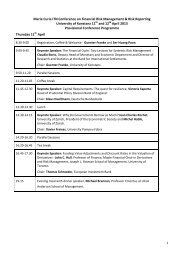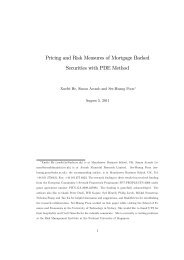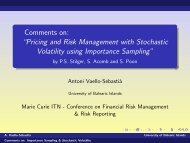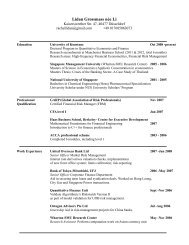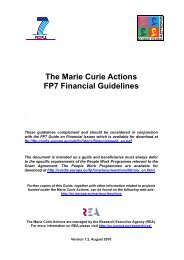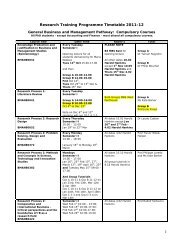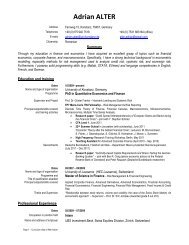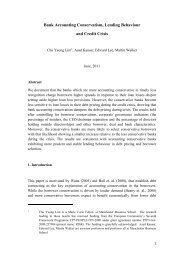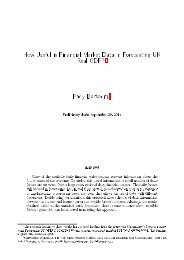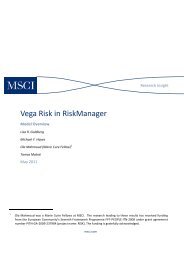Quantitative Finance - Art or Science?
Quantitative Finance - Art or Science?
Quantitative Finance - Art or Science?
You also want an ePaper? Increase the reach of your titles
YUMPU automatically turns print PDFs into web optimized ePapers that Google loves.
<strong>Quantitative</strong> <strong>Finance</strong> – <strong>Art</strong> <strong>or</strong><strong>Science</strong>?November 2009Manfred PlankManaging Direct<strong>or</strong>, Credit Risk Management,Analytics&Instruments+41-44-333 86 24manfred.plank@credit-suisse.com
Characteristics of <strong>Quantitative</strong> <strong>Science</strong>• <strong>Quantitative</strong> <strong>Science</strong> is always concerned with the measurement ofquantities and the discovery of the exact relationship betweendifferent quantities• Relationships between different quantities are described bymathematical equations where each variable <strong>or</strong> constant has a realw<strong>or</strong>ld interpretation and relationships, variables and constants arem && x =1Gm m1 22rmeasurable• The mathematical f<strong>or</strong>mulation must c<strong>or</strong>rectly describe all knownphenomena f<strong>or</strong> which it was designed and predict new phenomenawhich are not yet knownUransus1
Characteristics of <strong>Quantitative</strong> <strong>Science</strong>"One can sum up all this by saying that the criterion of thescientific status ofa the<strong>or</strong>y is its falsifiability, <strong>or</strong> refutability, <strong>or</strong> testability"(Karl Popper, 1963)2
Fundamental Principles and First ApplicationsClassical Mechanics• Newton's second law: the f<strong>or</strong>ce on an objectis equal to the mass of the object multiplied by itsaccelerationFinancial Economics• No Arbitrage: the existence of an equivalentmartingale measure f<strong>or</strong> a stochastic process ( S t) isessentially equivalent to the absence of arbitrage• Application – law of inertia:If there acts no f<strong>or</strong>ce on an object it moves with• Application - pricing of linear derivatives:F<strong>or</strong> a no income asset the relationship between theconstant velocity along a straight line; i.e.m &1x= 0f<strong>or</strong>ward F 0and the spot price S 0isF0 = S0erT• Testability:• Testability:An object's velocity & traject<strong>or</strong>y are observableand measurable and observations & experimentsconfirm the predictionRisk free rate, f<strong>or</strong>ward and spot price are observableand measurable and observations & experimentsconfirm the prediction3
<strong>Science</strong> and <strong>Art</strong>Universal Law of Gravitation Geometric Brownian Motionm m& tt1 21xG2G= (6.67428 +/- 0.00067) x 10-11 m3 kg-1 s-2 dB B rdtt=tm =rdS= S μdt+ S σdWtt⇒ f 0= e−rTEQ[ f ( S )]T• All variables and constants are measurable &theref<strong>or</strong>e their functional relationship can betested• All variables and constants are measurable &theref<strong>or</strong>e their functional relationship can betested• Known empirical phenomena, like Kepler's laws,can be deducted from the mathematical model• Known empirical phenomena like fat tailed equityreturn distributions <strong>or</strong> non-constant volatilitiescannot be deduced from this model• New predictions, like the existence of newunknown planets, are made & verified throughobservations <strong>or</strong> experiments• The model does not make any new predictions &predicted derivative prices are in contradictionwith observed prices• Findings do not change if we replace above models by m<strong>or</strong>e sophisticated versions4
Implications f<strong>or</strong> Financial Risk Management• How it is• ... and how it should be• Mathematical models are used to quantify risks– the math is right; the problem is that it does notdescribe the real w<strong>or</strong>ld in a quantitative way• Mathematical models should help to understand risks– the math is right & it should help us to describe the realw<strong>or</strong>ld in a qualitative way• Risk management decisions are delegated tomathematical models & judgment cast aside• Risk management decisions should be based onjudgment & mathematical model insights5
Implications f<strong>or</strong> Financial Risk Management cont'd• How it is•... and how it should be• The principle of "No free lunch" is repeatedlyign<strong>or</strong>ed resulting in significant losses– Amplified M<strong>or</strong>tgage P<strong>or</strong>tfolio Super Seni<strong>or</strong> trades– Negative Basis Trades• As a risk manager never accept trades generating"risk free" profits– End of 2007 AMPS contributed 67% and NBT10% of UBS total Super Seni<strong>or</strong> losses• Dig into details bef<strong>or</strong>e the big picture isunderstood• Understand the big picture bef<strong>or</strong>e you dig into thedetails6
Implications f<strong>or</strong> Financial Risk Managementcont'd• How it is• Facts are ign<strong>or</strong>ed– over the last 24 months Risk Management toolshave blown up repeatedly• Some risk managers act as if there would existgod given laws f<strong>or</strong> financial economics– Human being have a choice• Countries can close their exchange• Central banks can reduce rates• Governments can bail out banks <strong>or</strong> allow them to fail• Regulat<strong>or</strong>s change the rules of the game (sh<strong>or</strong>t selling)• ... and how it should be• Make sure that models w<strong>or</strong>k under extreme scenarios& use tail<strong>or</strong> made stress scenarios to understand tailrisk• Understand why people do the trades they do– VaR and stress loss framew<strong>or</strong>ks are often arbitraged• Never assume that certain scenarios cannot happen– the fact that we are still alive does not make us imm<strong>or</strong>tal• Make sure that you understand in detail the business& the people doing it• It is all about people & their behavi<strong>or</strong> & not so muchabout modeling7
Key Benefits of Financial Models• Financial Models allow us to understand and analysis potential risks in a structured,objective & consistent way across the <strong>or</strong>ganization• Implementation of Risk Management tools always leads to tremendous improvements ininf<strong>or</strong>mation systems & make deficiencies transparent• Inc<strong>or</strong>rectly booked trades & sometimes (but not always) risk accumulations acrossdesks are made transparent• If I take models seriously they tell us when we should not apply them; i.e. do not includeilliquid securities in the trading book8
How does the big picture look like: Hist<strong>or</strong>ic Credit CrunchesData as of September 2009600500400300Rise in global credit spreads 1Looking at past experiences, financial marketstabilization could be still far away• 1930• 1979• 1990• Current crisis 22001000SOURCE: Moody’s0 10 20 30 40 50 60 70 801 Shocks classified based on trough to peak rise in spreads and duration2 European market only; indexed to 100 at spread level of October 2007, which marks the starting point of thecurrent crisisDuration of credit shockMonths9
How does the big picture look like: US - On the Real SideFed’s Unemployment Rate F<strong>or</strong>ecast1110Unemployment Rate (%)SepFOMC Central TendenciesQ4 avg20092010201198765LongerRun6Time To Recovery(Number of quarters it takes the level of real GDPto get back to previous cycle peak, startingfrom last quarter of the recession)4Jan 2008 Jan 20095Sources: Federal Reserve, Credit Suisse. 2009 central tendency is9.8% to 10.1%, 2010 is 9.5% to 9.8%, 2011 is 8.4% to 8.8%, andlonger run 4.8% to 5.0% on a Q4 average basis.432101960-61 1970 1973-75 1980 1981-82 1990-91 2001 CurrentF<strong>or</strong>ecastSources: Bureau of Economic Analysis, Credit Suisse. End-quarter ofcurrent recession expected to be Q2 2009.10
Visible Risks1. The reach f<strong>or</strong> yield continues to supp<strong>or</strong>t existing rise of asset prices. They almost surely won’t goup as they have in the last six months, but it’s hard f<strong>or</strong> them to go down against the backdrop ofunrenumerative cash. This is great f<strong>or</strong> PMs, but it’s a misery f<strong>or</strong> CIOs and CEOs and businessmodels where asset yields get too low to cover liability costs. Watch out f<strong>or</strong> pension funds &insurance companies2. Risk management models have blown up as th<strong>or</strong>oughly in the last six months when c<strong>or</strong>relationsamong asset classes went towards 1 (as everything rallied) as was the case bef<strong>or</strong>e whenc<strong>or</strong>relations were near 1 (with all assets selling off). The difference, of course, is that peoplearen’t as sensitive to failures in the risk management models when prices are going up as whenthey’re going down. Black swans have fat tails; so do white swans3. We move into a time of over-regulation where decision makers still believe that financial risks canbe controlled & managed by mathematical models. Sound risk management cannot bedelegated to a model4. FED balance sheet management is complicated/compromised by the Treasury’s debt ceilingproblem leading potentially to some money market accidents5. A lot of seni<strong>or</strong> executives were fired in the financial industry over the last two years, but no seni<strong>or</strong>regulat<strong>or</strong> had to resign12



